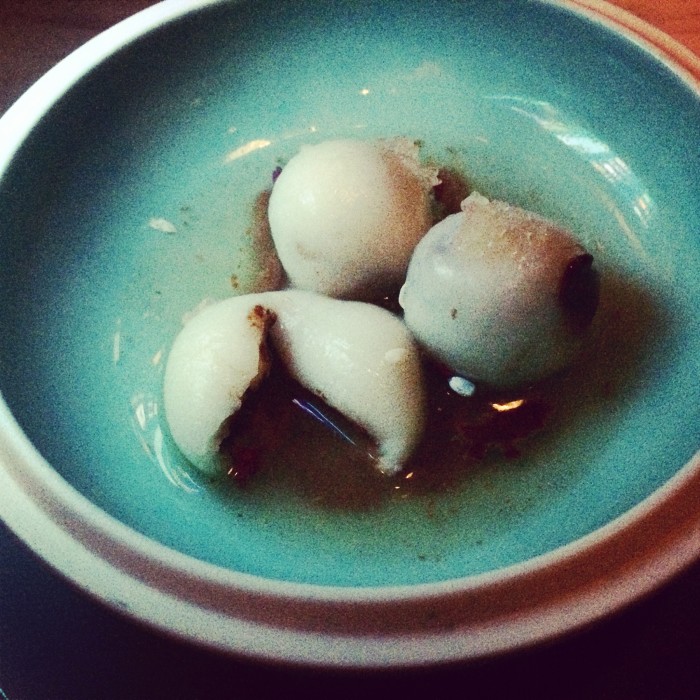What Makes For A Perfect Asian Dessert? Let's Ask Pichet Ong.
In June, Food Republic is counting the many reasons to love Asian food in America right now. Here's one of them.
New York pastry chef Pichet Ong grew up in Thailand, Hong Kong and Singapore, and it shows in his work and tastes. With a résumé that includes Jean Georges Vongerichten's 66, Spice Market and progressive dessert bar P*ONG, Ong utilizes flavors from his childhood in desserts such as sweet dim sum, mango pudding and Ovaltine Kulfi.
Ong says that the types of Asian desserts that appeal to him most are the ones that are "transcontinental interpretations" that come into being after travel and exploration. For example, Hong Kong's famous egg tart can be traced back to Portugal. Japan's version of the European castella cake also comes to mind.
While articulating the power of these flavors, Ong called living in New York (his longtime home) a "sacrifice" because some of the ingredients aren't up to par compared to those in the motherland.
"When I travel to Asia, especially in Thailand, it's a whole different ball game," he says. "Every dessert there is made with far better products, like coconut milk, and the tropical fruits are far better."
However, Ong tells Food Republic that there are some great twists on classics that can be found here in America.
Here are his favorite Asian desserts and where you can taste them around the United States:
Shaved ice
Ong says that this common and versatile classic has evolved into refreshing treats that are great at the end of a meal.
"There's a very fine type of shaved ice that's like snow and really beautiful, but there's also really traditional, just pounded ice, like big chunks of it, in soup-based desserts with fruit and ice cream that's really lovely," he says. "There's a whole gamut of it that goes from more common ingredients such as corn, beans, ice cream and tropical fruits to more institutionalized, with chocolate, cake and other products."
Also working as a sort of beverage, shaved ice pairs especially well if you're enjoying something oily or spicy. You can sample a version of the dessert at Benu in San Francisco. "Courtney Schmidig of Benu pushes the envelope a lot with simple iconic ingredients and transforms them into miniature wonders [that are] technically challenging, too, like her shaved ice and honey dessert," Ong says.
Mango pudding
This jiggly, orange treat served with evaporated milk can be found in dim sum houses across Hong Kong and has made its way to America. However, Ong says that in the migration, mangoes have been reduced to powders that don't present the same flavors.
"It's really unfortunate that over here, the mango is not quite the same, and the dim sum houses use a mix that's quite artificial-tasting," he says. "When I did my version for 66 for Jean Georges, we used fresh ingredients, and it was closer to what I had in fine dim sum houses in Hong Kong."
A noteworthy version of the dessert can be tasted at New York's Buddakan, but you'll have to plan accordingly because the menu there changes frequently.
Mochi
Sometimes filled with ice cream, strawberries or sweetened red-bean paste, this gummy, rice flour confection comes from Japan. Ong likes this dish particularly because of the "chewy texture," calling it "very lovely."
In a marriage of East and West, Rory Macdonald at Hakkasan (with locations in Miami, Las Vegas and Beverly Hills) combines chocolate and mochi to create something that Ong says is "a nice, full-body finish to a meal."
"They have a chocolate version that I think is very appealing, more appealing for someone who's not used to the texture, and the chocolate makes it more palatable," he says.
Something fried
From bananas to just dough, Ong says you can find fried desserts "all over continental Asia."
There's a whole world of Asian desserts out there, and now that chefs are adding their own cultural flair to them, that world is always expanding. Other noteworthy chefs that are creating sweet treats, according to Ong, include Andy Ricker (Pok Pok, Portland, Oregon), Jennifer Yee (Lafayette Patisserie & Restaurant) and recent James Beard finalist Maura Kilpatrick (Sofra Bakery and Oleana, Cambridge, Massachusetts).
With inspirations that draw from northern Thailand, Pok Pok is "part homey and part street," Ong says. And with that, Ricker tops an ice cream sandwich with corn, a classic in Thailand.
Meanwhile, Yee "employs some Asian flavors that she loves in her repertoire, even though the theme is French," Ong says. Similarly, Kilpatrick infuses Middle Eastern and South Asian spices into her pastries.


